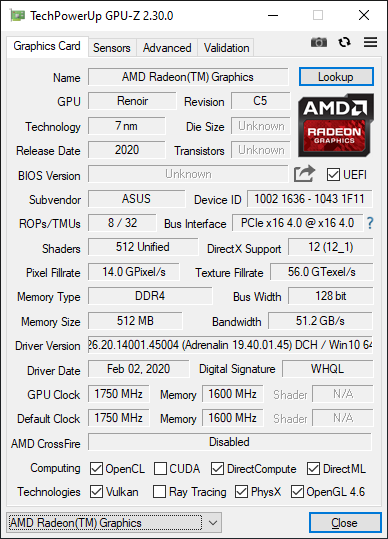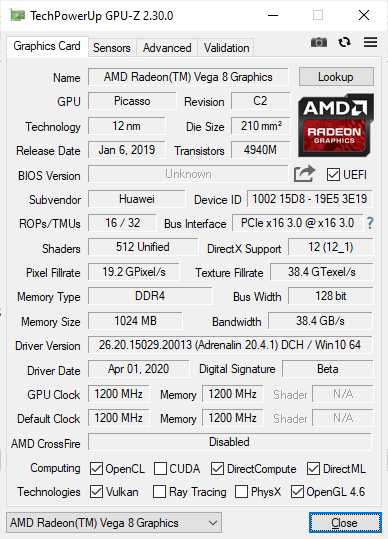AMD’s Mobile Revival: Redefining the Notebook Business with the Ryzen 9 4900HS (A Review)
by Dr. Ian Cutress on April 9, 2020 9:00 AM ESTTesting the Ryzen 9 4900HS Integrated Graphics
Under the hood of the Ryzen 9 4900HS, aside from the eight Zen 2 cores, is an enhanced Vega 8 graphics solution. For this generation of mobile processors, AMD is keeping the top number of compute units to 8, whereas in the previous generation it went up to Vega 11. Just by the name, one would assume that AMD has lowered the performance of the integrated graphics. This is not the case.
For the new Ryzen Mobile 4000 processors, the Vega graphics here are enhanced in three main ways over the previous generation. First is that it is built on the 7nm process node, and AMD put a lot of effort into physical design, allowing for a more optimized version that has a wider voltage/frequency window compared to the previous generation. Secondly, and somewhat connected, is the frequency: the new processors top out at 1750 MHz, rather than 1400 MHz, which would naturally give a simple 25 % boost with all other things being equal. Third on the list is memory, as the new platform supports up to DDR4-3200, rather than DDR4-2400, providing an immediate bandwidth boost which is what integrated graphics loves. There’s also the nature of the CPU cores themselves, having larger L3 caches, which often improves integrated graphics workloads that interact a lot with the CPU.
Normally, with the ASUS Zephryus G14, the switching between the integrated graphics and the discrete graphics should be automatic. There is a setting in the NVIDIA Control Panel to let the system auto-switch between integrated and discrete, and we would expect the system to be on the IGP when off the wall power, but on the discrete card when gaming (note, we had issues in our battery life test where the discrete card was on, but ASUS couldn’t reproduce the issue). In order to force the integrated graphics for our testing, because the NVIDIA Control Panel didn’t seem to catch all of our tests to force them onto the integrated graphics, we went into the device manager and actually disabled the NVIDIA graphics.
This left us with AMD’s best integrated graphics in its Ryzen Mobile 4000 series: 1750 MHz of enhanced Vega 8 running at DDR4-3200.

Renoir with Vega 8 – updated to 20.4 after this screenshot was taken
Our comparison point here is actually a fairly tricky one to set up. Unfortunately we do not have a Ryzen 7 3750H from the previous generation for comparison, but we do have an Honor Magicbook 14, which has a Ryzen 5 3500U.
This is a 15 W processor, running at 1200 MHz and DDR4-2400, which again makes the comparison a little tricky, but it is better than comparing it to the Intel HD630 graphics in the Razer Blade.
We also re-ran the benchmarks on the latest drivers with AMD's 65 Desktop APUs, the Ryzen 5 3400G (with Vega11) and the Ryzen 3 3200G (with Vega 8). These are running at DDR4-2933, the AMD maximum officially supported by these APUs (which means anything above this is overclocking).


This is a pretty substantial difference, no joke.



Hopefully we will get more variants of the Ryzen integrated graphics to test, along with an Ice Lake system.











267 Comments
View All Comments
Deicidium369 - Sunday, April 12, 2020 - link
Thing is AMD is not their largest customer - they also build for Apple and Nvidia - so NO, TSMC could NOT deliver the same volume as Intel - not even close.Qasar - Sunday, April 12, 2020 - link
and intel cant deliver 10nm in volume, point is ?Namisecond - Monday, April 13, 2020 - link
Until we know actual numbers, Intel's "Can't deliver in volume" may still be more than the volume AMD can. To the point where they win the OEM contracts.Qasar - Monday, April 13, 2020 - link
and i STILL cant buy any 10nm based chips from intel, that kinda points to cant deliver in volume to me. some markets are getting them, but my local computer stores, best buy, or other stores that sell notebooks, dont have any.Deicidium369 - Monday, April 13, 2020 - link
I bought 2 Dell 2-in-1s back in October - both 10nm Ice Lake, both i7-1065G7s. The fact you can't seem to locate them at the Goodwill where you shop, doesn't change the fact they are around, and no problem to get.try http://www.dell.com
Qasar - Monday, April 13, 2020 - link
and yet more insults.. that all you got now ?? grow upDeicidium369 - Monday, April 13, 2020 - link
I would bet you that Intel has sold more 10nm than AMD has sold period. The idea that Intel can't deliver silicon is a cute story. Intel 10nm is in like 20 different designs, and there are other 10nm products other than the laptops stuff. So they are delivering it in volume - for close to a year now - and they signaled that by making the Cooper Lake 4 and 8 socket only and only having 10nm Xeon in 1 and 2 socket.Qasar - Monday, April 13, 2020 - link
" I would bet you that Intel has sold more 10nm than AMD has sold period " yea right, prove it.. most some links instead of your intel biased BSagain.. just be cause YOU were able to by intels 10nm stuff where YOU are, doesnt make it high volume, and to quote dell as being a source, good one, guess what dell as used intel for MOST of the time its been in business, and there for, more then likely gets first dibs.
Namisecond - Monday, April 13, 2020 - link
If TSMC were exclusively working on AMD stuff, possibly, but TSMC has more steady and more lucrative customers like Nvidia, Qualcomm and Apple. To make matters worse, AMD is also tying up valuable fab time with their console SoCs.Namisecond - Monday, April 13, 2020 - link
World's largest fab or not, You can't just throw some money at TSMC and demand more wafers overnight. Last I checked, TSMC was at capacity and was not accepting new orders for anything less than 18 months into the future. This is how contract suppliers work. AMD also has the problem of game console SoCs tying up their available fab capacity at TSMC. Intel owns their own fabs. If they can get their shit sorted out, they won't have capacity problems like this. Just because Gondalf makes bad fanboi arguments doesn't mean you have to lower yourself to his level.